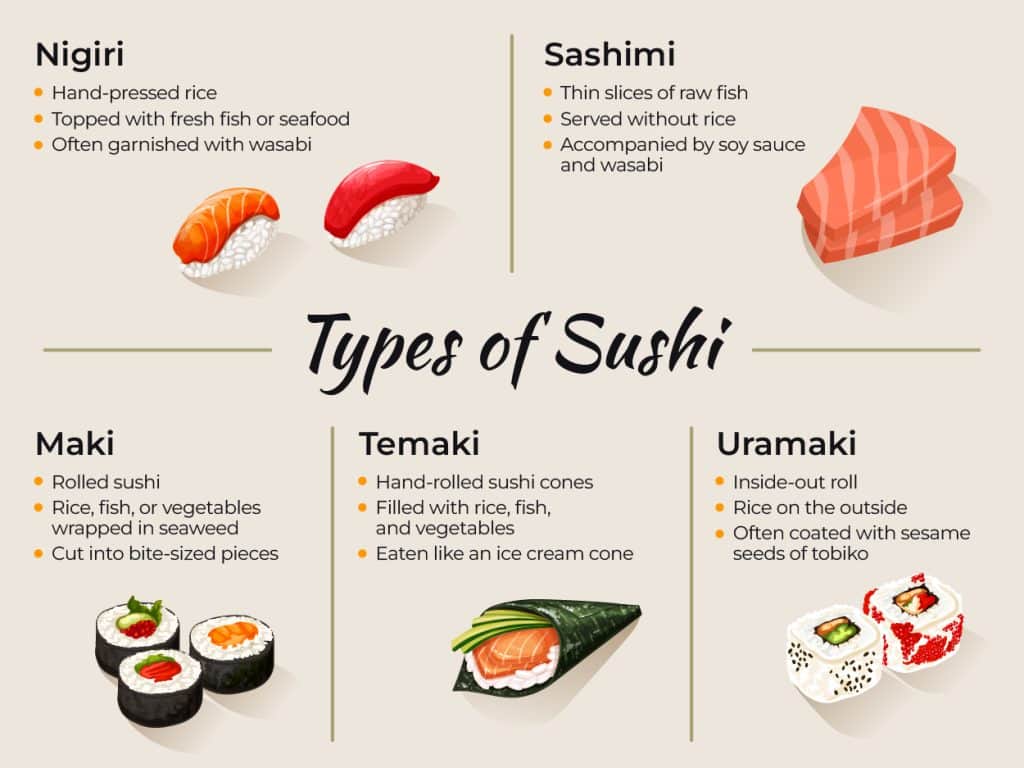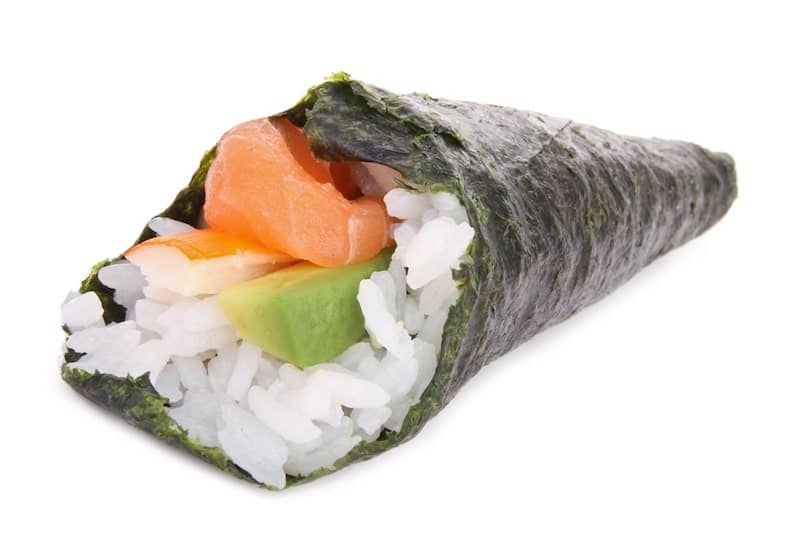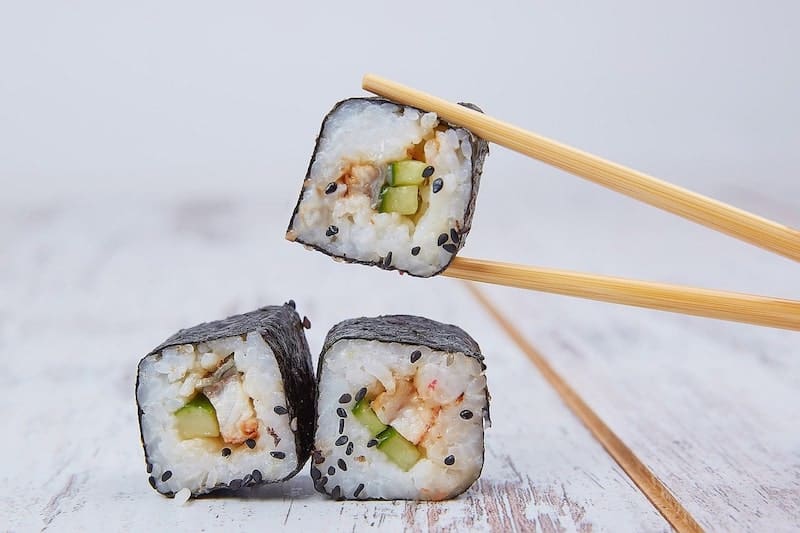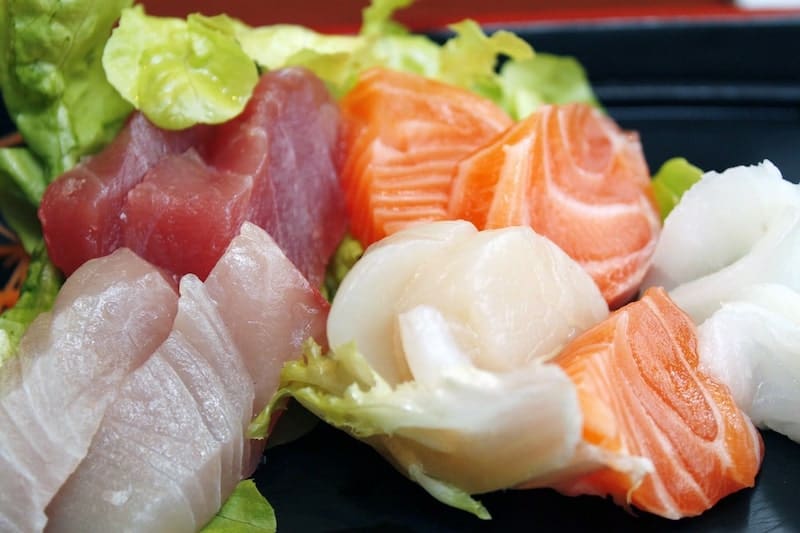What is Sushi, Exactly? (The Ultimate Guide)
If you’re new to sushi and want to know the basics of what it’s all about, you’re in the right place.
Read on to learn about what sushi is exactly, what types of sushi there are, and a dive into its common ingredients – raw fish, rice, and seaweed.
What is Sushi?
Sushi is a dish that originates from Japan, and its main ingredients consist of raw fish and vinegared rice (called sumeshi).
There are a few different styles of sushi that vary in how the fish and the rice are presented together. For example, the sushi most people know about, called maki, is seaweed that’s rolled around the fish and rice.
See the table below for a look at the different types of sushi.
Types of Sushi

Maki
Maki is a roll of sushi that’s cylindrical in shape when it’s first made and is then sliced. It consists of raw fish, vinegared rice, and any other ingredients rolled up in seaweed.
Uramaki
Uramaki is the “inside out” version of maki. The rice makes up the outer layer (which can also have toppings like panko on it), with the next, inner layer being the seaweed that’s wrapped around the fish and other ingredients.
Temaki
Temaki is also referred to as a hand roll. It’s a fairly large cone of seaweed that’s stuffed with rice, raw fish, and other ingredients (think an ice cream cone).

Nigiri
Nigiri, which means “two fingers,” looks just like the name suggests. It’s a small roll of rice shaped in a rectangle that’s topped with a single piece of raw fish.
Sashimi
Sashimi is nigiri without rice. So in other words, it’s a single piece of raw fish.
Chirashi
Chirashi means “scattered” and is basically a sushi bowl, where all of the sushi ingredients are served deconstructed in a bowl.
Is Sushi Actually Raw Fish?
Traditional sushi is made with raw fish, but not all sushi is made with raw fish.
Although today, you can find sushi with just vegetables (like cucumber, avocado, or even sweet potato) or even with fried shrimp or other seafood (generally called tempura rolls). And if you make it yourself, you can really put whatever you want in it!
Raw fish used for sushi is carefully selected, sushi-grade (meaning that it’s safe to eat raw) fish.
You can’t just use any type of fish for both health and taste reasons. Here are some of the most common types of fish (and other seafood) used for sushi:
- Salmon
- Tuna
- Mackerel
- Yellowtail
- Halibut
- Monkfish
- Eel
- Octopus
- Shrimp
- Squid
- Uni
Is Sushi the Rice or the Fish?
Believe it or not, the word “sushi” is actually referring to the rice, not the fish.
It translates to “sour tasting,” which refers to the specific way that rice is prepared with vinegar to make sushi.
What is Sushi Rice?
Sushi rice is Japanese, short grain rice that’s steamed and flavored with vinegar-based ingredients.
Really only this type of rice is used to make sushi because of its sour flavor, sticky consistency, and firm texture, which are ideal for constructing sushi and pairing with the flavor profiles of its key ingredients.
Is Sushi Made with Seaweed?
The more common types of sushi like maki and uramaki are made with seaweed, called nori. You’ll also find nori in temaki and chirashi bowls.
Nori is dried seaweed that, despite its dark green color, actually comes from red algae.
It’s purchased in large sheets that are toasted, then used to wrap the raw fish and other ingredients in sushi and adds a distinct flavor of the sea into each bite.
In Summary
Hopefully this article answered your questions about what sushi really is and familiarized you with the types of sushi you can get and the key ingredients used to make it.
Be sure to check out my other articles that dig deeper into sushi making and address some common questions!











